A guide to the latest presbyopia-correcting IOLs
Latest offerings create myriad options for patients who desire freedom from glasses
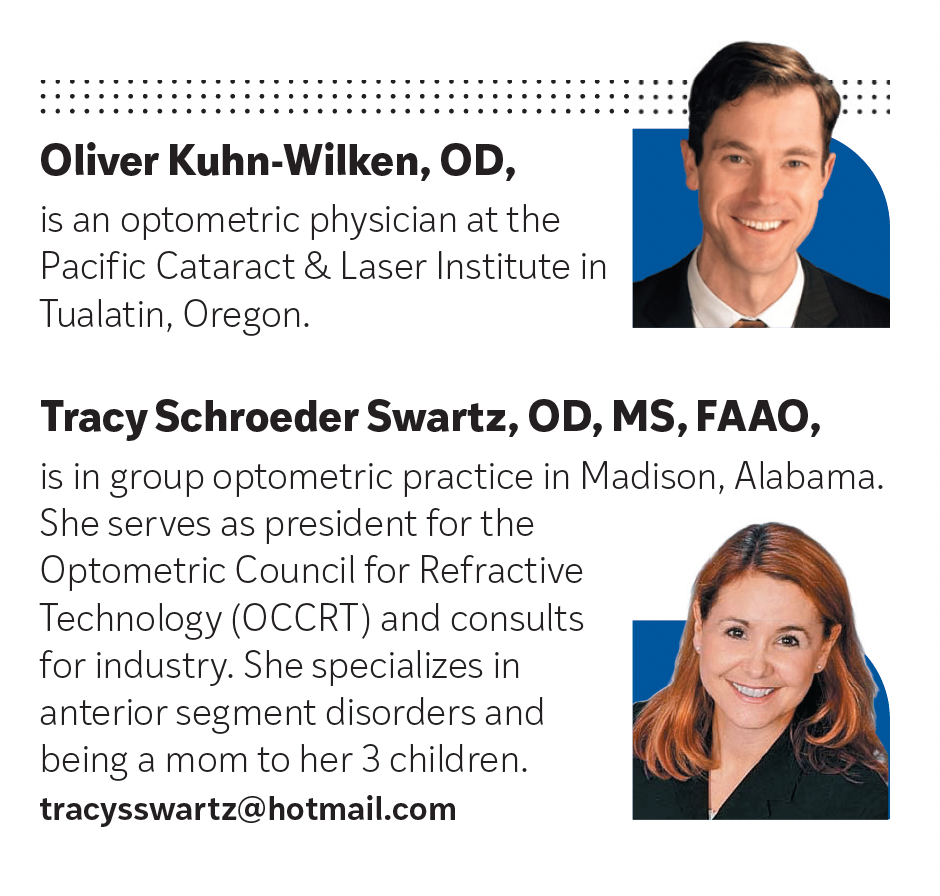
The number of presbyopia-correcting intraocular lenses (IOLs) has been growing rapidly, making it more difficult to accurately counsel patients about lens options. Since the first multifocal IOL was introduced to the US market in 1997, the number of multifocals available has increased exponentially.
Twelve models have been released in the US, and there are over 100 available internationally or in development waiting for approval from the US Food and Drug Administration (FDA).1 This growth has created anxiety for eye care providers, who must guide their patients’ decisions based on information that is hard to discover, muddled by marketing, and impossible to verify firsthand. Surgeons and doctors are increasingly confused by the new choices.
We will discuss the advantages and disadvantages of recently FDA-approved IOLs, how the changing technology has affected appropriate patient selection and counseling, and what to expect if your patient receives these lenses.
As technology improves, our candidate pool for these high-performance lenses grows. Each lens has unique advantages and compromises, so successfully selecting a lens for a particular patient depends on a thorough understanding of the patients’ priorities and each IOL’s characteristics.2
No free lunch in optics
True accommodation is difficult to duplicate. Unfortunately, the laws of physics prohibit the creation of an ideal multifocal IOL. It is impossible to create a lens that gives a perfect image of targets at varying distances with no increase in aberrations and no loss of light.
The Crystalens AO (Bausch + Lomb) was the first and remains the only accommodative lens approved for use in the US. Despite strong results in the FDA trials for this lens, real-world results were mixed. The Array multifocal (Allergan) was the first to combine aspheric and spherical optics with progressive transitions between the 5 zones. However, nighttime vision was problematic, leading to frequent patient rejection. The ReZoom (Advanced Medical Optics, Inc) and Restor +4.0 (Alcon) followed, but its diffractive optics created significant dysphotopsias.3,4 The Restore +3.0 and later the +2.5 (active-focus) somewhat reduced patient complaints, but eye care providers (ECPs) remained wary of disappointing patients.
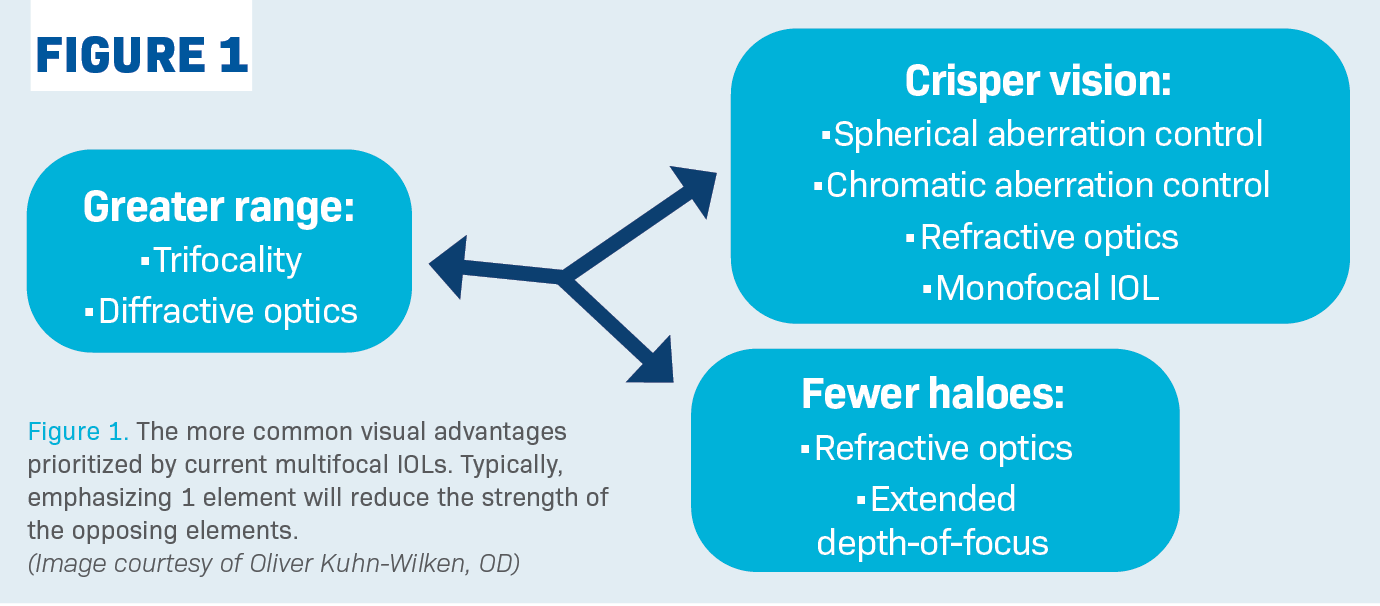
Figure 2: A defocus curve shows at a glance what the average patient should be able to see over a range of distances. Defocus curves are created by distance correcting the patient, then presenting a series of lenses in front of their eye and measuring the degree of defocus that is induced. Here are sample defocus curves for 4 multifocal IOLs (Symfony, Vivity, PanOptix, and Synergy) that are superimposed, although defocus curves often vary between studies.28-29 Bear in mind that superior defocus curves (ie, less defocus with near targets) are often accompanied by an increase in other optical issues..
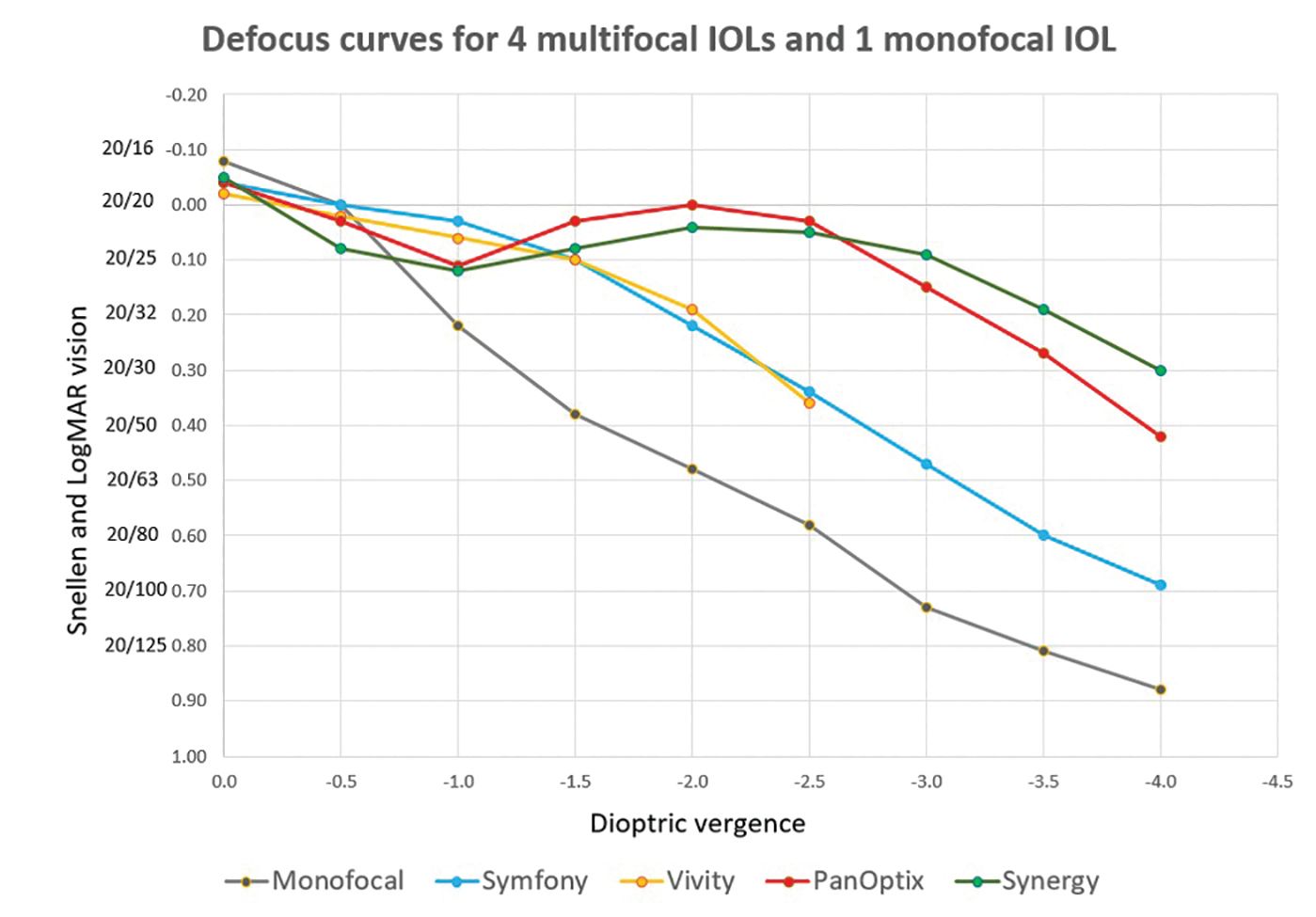
The key to navigating the selection of a successful multifocal IOL is an intimate knowledge of the advantages and compromises inherent in each IOL. When that knowledge is combined with a clear understanding of a patient’s desires, their satisfaction with the final decision is much more likely.5 Some of the more common strengths of the current multifocal IOLs are shown in Figure 1, in which prioritizing 1 wing of the triad will likely result in a compromise in the other 2 wings.
We must still preoperatively evaluate any patient’s appropriateness for multifocal IOLs; consider performing topography to rule out corneal abnormalities and optical coherence tomography to assess the macula. Measure angle alpha, although this appears to be less of an issue with newer extended depth-of-focus (EDOF) IOLs. For many patients, multifocal IOLs are not good idea, whether it be because of ocular pathology, temperament, additional cost, vagaries of neural-adaptation, effect on daytime and nighttime vision, or simply an affection for glasses. It is unwise to pressure these patients.6
However, improved optical strategies in newer multifocal IOLs mean more patients are good candidates for these lenses. Currently available presbyopia-correcting IOLs are listed in Table 1. Some of these are toric lenses, so we have also included Table 2 to describe power options for patients with corneal astigmatism.
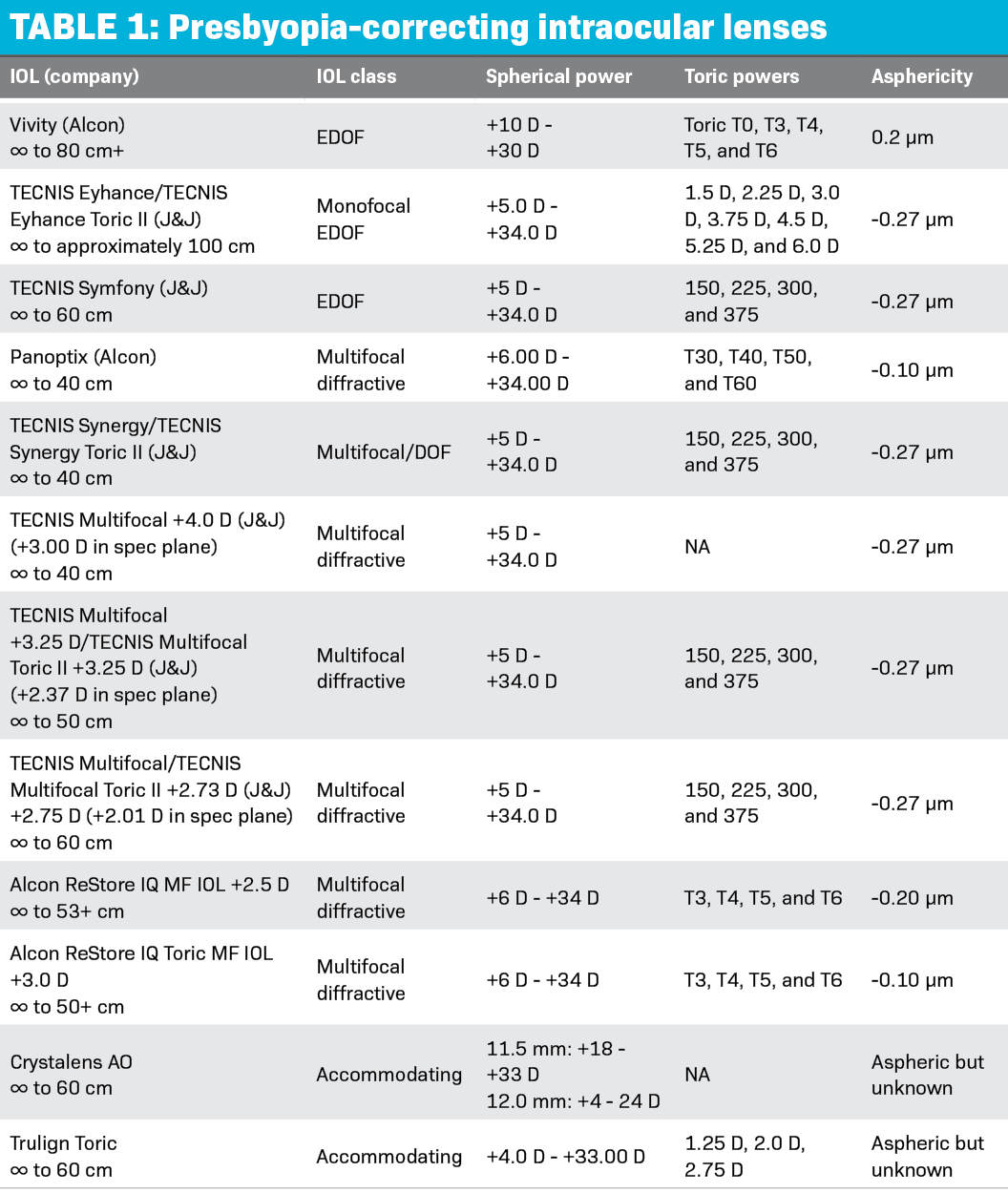

The EDOF IOLs
No category of multifocal IOLs has grown more rapidly in the last few years than that of the EDOF IOLs, which have been FDA regulated separately from monofocals and other multifocals since 2016. The FDA defines EDOF IOLs as lenses that provide Snellen visual acuity to within 1 letter of that provided by a monofocal IOL, and a depth of field that is at least 0.50 D greater than a monofocal.7
A half diopter of added depth of field may not sound like much of an improvement, but bear in mind that a monofocal will typically provide 0.75 D to 1.00 D of depth of field, depending on pupil size. Increasing that to 1.25 D to 1.50 D brings objects that are only 24 in to 30 in away into focus, which can include vehicle dashboards, computer monitors, and tablets.
Modesty of ambition for the depth of field allows EDOFs to minimize aberrations that plague the more powerful multifocal IOLs. They are well suited to patients with active lifestyles; People who want some depth of field to lessen their dependence on glasses, but do not mind resorting to glasses to read for prolonged periods, read smaller print, or read in dim light.
TECNIS Symfony
TECNIS Symfony, an EDOF lens released in the US in 2016 (Johnson & Johnson) was, for many surgeons, the first presbyopia-correcting IOL that would work for a significant number of patients.
The Symfony uses diffraction to split light between 2 fairly close foci, resulting in a bifocal IOL with focal peaks at plano and at +1.75 D (22”). These peaks are close enough that in most lighting conditions, patients experience a continuous plateau of good vision all the way from infinity to intermediate distance. In dim lighting, a perceptive patient may notice 2 separate peaks.8
The TECNIS Symfony comes in a spherical and a toric version. The toric model can correct for corneal astigmatism (not total refractive astigmatism) between 1.0 and 2.6 D.9 The TECNIS Symfony is a diffractive lens, and it has a concentric sawtooth surface pattern similar to all diffractive IOLs.10 Any diffractive lens will produce glare, haloes, and starbursts, referred to as dysphotopsias. The TECNIS Symfony gives these effects as well. Although in our experience, it seems to produce fewer complaints than those of non-EDOF diffractive IOLs.
One additional strategy employed by the TECNIS Symfony is a reduction in chromatic aberration achieved by manipulation of the diffractive design, resulting in superior contrast sensitivity compared with most other multifocal IOLs.11 Diffractive optics will generally reduce contrast sensitivity, the ability to discern objects with similar color and brightness, especially in low lighting. Any corneal or macular disease will also reduce contrast sensitivity, so all diffractive IOLs are contraindicated with these diseases to avoid any cumulative decrease in contrast sensitivity.12
The TECNIS Symfony tends to give good distance and intermediate vision, but may not give sufficient reading vision for some patients, those patients will require reading glasses. Some patients are amenable to a strategy of mini-monovision, whereby the nondominant eye is targeted at -0.50 D. This slight adjustment can give more functional uncorrected near vision.13 In general, the TECNIS Symfony is an excellent IOL for patients who desire good distance and intermediate vision and do not mind some compromise to their near vision and some nighttime aberrations.
The Vivity
The Vivity IOL (Alcon), another EDOF lens, was approved by the FDA in late 2020 and was generally well received. In contrast to the TECNIS Symfony and multifocal IOLs, the Vivity is a refractive lens. This combines 2 smooth surface transition elements to simultaneously stretch the wavefront, creating an extended visual range without splitting the light. A smooth, slightly elevated (approximately 1 µm) plateau surrounds a 2.2-mm small curvature change to delay the wavefront passing through this section of the IOL. This focuses the central light more for near. The wavefront passing around the central section travels faster to focus light more toward the distance vision. This is not a diffractive lens. It functions as an EDOF IOL with continuous vision from infinity to about 26 in (+1.50 D).14
The Vivity is available in a spherical and a toric version (T3-T6). Despite its weaker near power than previous EDOF IOLs, patients have been enthusiastic about the reduction in dysphotopsias. Its refractive design results in nighttime aberrations similar to a monofocal. Perhaps this is why patients commonly describe their vision through this lens as “natural.”15
Because of the minimal aberrations, the Vivity can sometimes be implanted in patients with mild corneal or macular disease, as long as they receive appropriate counseling. Thus the Vivity has significantly expanded our pool of potential candidates for multifocal IOLs.
The Vivity should give good distance and intermediate vision, but like other EDOFs, it does not usually give good near vision. If acceptable to the patient, a mini-monovision strategy can bolster near vision considerably.16 Vivity is a good choice for patients who want good distance and intermediate vision, who do not mind wearing reading glasses for some near tasks, and who either would dislike any glare or haloes or have mild corneal or macular disease.
TECNIS Eyhance
The TECNIS Eyhance IOL (Johnson & Johnson) was launched in June 2021. Eighty five percent of the surface of the TECNIS Eyhance is the same as the TECNIS 1-Piece IOL, but the center creates an increase in power to slightly increase the depth of focus. In the US, it is classified as a monofocal IOL rather than an EDOF, with surgical planning attributes of a traditional monofocal lens.
The lens was designed to improve intermediate vision while providing distance vision comparable to a traditional monofocal lens. A prospective study comparing the TECNIS Eyhance with the TECNIS monofocal found no significant difference in patients’ experience of halos, glare, or starburst 6 months after surgery. More than 80% of patients in both groups reported no problems with glare, halos, starbursts, or overall vision 6 months after surgery. Patients with the TECNIS Eyhance IOL had significant improvements in distance-corrected intermediate vision and uncorrected intermediate vision of at least 1 line compared with a traditional TECNIS monofocal lens. Maximum plus refraction technique is recommended for patients following implementation of this lens, and autorefractors may not provide optimal postoperative estimation for refraction because of the optical design.17 The TECNIS Eyhance Toric II is available with cylinder powers for up to 4.1 D of astigmatic correction at the corneal plane.
Multifocal IOLs
The history of patient rejection of bifocal IOLs because of daytime clarity issues and night vision dysphotopsias makes many ECPs nervous, but the most recent options in this category have improved optics and are gaining more acceptance. Outside the US, surgeons have already been using a wide range of trifocal implants, most commonly AT LISA (Carl Zeiss Meditec) and FineVision (PhysIOL). In the US, we have been fortunate to see 2 advanced lenses recently obtain FDA approval.
PanOptix
Although there are dozens of trifocal IOLs available internationally, PanOptix (Alcon) is the first trifocal IOL released in the US. It achieves its effect with a sophisticated series of diffractive steps molded onto its anterior surface.18 The PanOptix has 3 focal points: emmetropia, 24 in (+1.67 D at the corneal plane) and 16 in (+2.50 D at corneal plane). The PanOptix is available in spherical powers as well as toric correction for corneal cylinder of about 1.00 to 2.50 D. Technically a quadrifocal, the lens combines light from 2 of its diffractive steps to plano, with the other 2 steps directed to intermediate and near, such that light is distributed 50% to distance and 25% each to near and intermediate.
The PanOptix is contraindicated in eyes with corneal or macular disease because diffractive optics degrade contrast sensitivity to some extent. This effect is compounded by dry eye, basement membrane dystrophy, epiretinal membranes, diabetic retinopathy, and other corneal and macular disease. The PanOptix does produce glare and haloes, but they are less than those of previous bifocal IOLs because some of the diffracted waves that are wasted in a bifocal are used for nearer points of focus in the trifocal.19
Sudhir et al performed a retrospective analysis comparing the PanOptix with 2 trifocal IOLs available internationally, the Fine Vision and the AT LISA, as well as the TECNIS Symfony.20 Although just 17% of PanOptix patients reported “often use” of reading glasses, 87% of TECNIS Symfony patients did. Higher energy utilization combined with a small diffractive zone (4.5 mm) compared with the other trifocals and the TECNIS Symfony (6 mm) results in functional vision that is less dependent on pupil size and lighting conditions and possibly with better contrast sensitivity. In this study, the PanOptix patients reported less bothersome halos, glare, and starbursts compared with the TECNIS Symfony IOL.21
The PanOptix tends to give good distance, intermediate, and near vision, with nighttime aberrations that are acceptable to the majority of patients.22-23 Although in most cases, the distance vision will not be as crisp as that of an EDOF IOL, this lens would be a good option for a patient who desires good vision across a wide range of distances, with less dysphotopsias compared with older diffractive multifocal IOLs.
TECNIS Synergy
Johnson & Johnson released the TECNIS Synergy to the US market in May 2021, so there is less experience and few independent published analyses of its characteristics. The TECNIS Synergy is a diffractive lens that combines multifocal and EDOF technology and purports to give good vision in a near-continuous sweep from plano to 12 in (3.00 D), an impressive range. It is a diffractive IOL with a syncopated concentric sawtooth pattern lathed onto its posterior surface and uses a frosted edge to reduce peripheral aberrations.25
The TECNIS Synergy incorporates many of the same strategies that Johnson & Johnson pioneered with the TECNIS Symfony, including correction for both the spherical aberration and the chromatic aberration of the cornea. It comes in a spherical version, and a toric that can correct for between 1.0 and 2.6 D of corneal cylinder.26
Johnson & Johnson attempted to reduce dysphotopsias using a violet light filter that blocks wavelengths of 360 to 460 nm. This specific filter may also minimize the effects from many LED lights. Like all diffractive IOLs, this lens is not recommended in any patient with corneal or macular disease. One study on the TECNIS Synergy suggested it may give acuities equal to or better than the PanOptix and outperform the PanOptix in mesopic conditions.27 Further investigations are underway.
The IC-8 Pinhole IOL
AcuFocus submitted a premarket approval application to the FDA for its IC-8 small aperture IOL in February 2021. This lens technology is based on a similar mechanism of action to the Kamra corneal inlay (AcuFocus Inc). The IC-8 is a spherical monofocal lens featuring an opaque annular ring with a clear central aperture diameter of 1.36 mm. The lens is designed to reduce the visual effects of unfocused peripheral light rays, allowing only central light rays to focus on the retina, thus delivering a continuous extended depth of focus.
A prospective, multicenter, nonrandomized clinical study was performed to evaluate its safety and effectiveness. The IC-8 was implanted in 1 eye, with a monofocal/monofocal toric lens in the other eye. Over 50% of patients reported spectacle independence at distance, intermediate, and near.30 The lens performed better than the FIneVision and AT LISA multifocal IOLs relative to induced astigmatism.31 Doctors have found it is still possible to do a fundus exam and even retinal procedures past this IOL.32
Conclusion
With the exponential increase in multifocal IOL options, we are entering a golden period for those desiring freedom from glasses. The more ODs understand the choices, the better we can counsel patients, and the more likely it is outcomes will match priorities.
References
1. Rampat R, Gatinel D. Multifocal and extended depth-of-focus intraocular lenses in 2020. Ophthalmology. 2020;S0161-6420(20)30931-3. doi:10.1016/j.ophtha.2020.09.026
2. Rudalevicius P, Lekaviciene R, Auffarth GU, Liutkeviciene R, Jasinskas V. Relations between patient personality and patients’ dissatisfaction after multifocal intraocular lens implantation: clinical study based on the five factor inventory personality evaluation. Eye (Lond). 2020;34(4):717-724. doi:10.1038/s41433-019-0585-x
3. Maurino V, Allan BD, Rubin GS, et al. Quality of vision after bilateral multifocal intraocular lens implantation: a randomized trial--AT LISA 809M versus AcrySof ReSTOR SN6AD1. Ophthalmology. 2015;122(4):700-710. doi:10.1016/j.ophtha.2014.10.002
4. Khandelwal SS, Jun JJ, Mak S, Booth MS, Shekelle PG. Effectiveness of multifocal and monofocal intraocular lenses for cataract surgery and lens replacement: a systematic review and meta-analysis. Graefes Arch Clin Exp Ophthalmol. 2019;257(5):863-875. doi:10.1007/s00417-018-04218-6
5. Alió JL, Pikkel J, eds. Multifocal Intraocular Lenses: The Art and The Practice. Springer International Publishing; 2014.
6. Braga-Mele R, Chang D, Dewey S, et al. Multifocal intraocular lenses: relative indications and contraindications for implantation. J Cataract Refract Surg. 2014;40(2):313-322.doi:10.1016/j.jcrs.2013.12.011
7. Kohnen T, Suryakumar R. Extended depth-of-focus technology in intraocular lenses. J Cataract Refract Surg. 2020;46(2):298-304. doi:10.1097/j.jcrs.0000000000000109
8. Loicq J, Willet N, Gatinel D. Topography and longitudinal chromatic aberration characterizations of refractive-diffractive multifocal intraocular lenses. J Cataract Refr Surg. 2019;45(11):1650-1659. doi:10.1016/j.jcrs.2019.06.002
9. Carones F. Residual astigmatism threshold and patient satisfaction with bifocal, trifocal and extended range of vision intraocular lenses (IOLs). Open J Ophthalmol. 2017;7:1-7. doi:10.4236/ojoph.2017.71001
10. Davison JA, Simpson MJ. How does the ReSTOR lens work? Review of Refr Surg. Oct 2004: Vol 5, no 4. 18-20.
11. Loicq J, Willet N, Gatinel D. Topography and longitudinal chromatic aberration characterizations of refractive-diffractive multifocal intraocular lenses. J Cataract Refract Surg. 2019;45(11):1650-1659. doi:10.1016/j.jcrs.2019.06.002
12. Alió JL, Pikkel J, eds. Multifocal Intraocular Lenses: The Art and The Practice. Springer International Publishing; 2014.
13. Sandoval HP, Lane S, Slade S, Potvin R, Donnenfeld ED, Solomon KD. Extended depth-of-focus toric intraocular lens targeted for binocular emmetropia or slight myopia in the nondominant eye: visual and refractive clinical outcomes. J Cataract Refr Surg. 2019;45(10):1398-1403. doi:10.1016/j.jcrs.2019.05.019
14. Kohnen T. Nondiffractive wavefront-shaping extended rand-of-vision intraocular lens. J Cataract Refr Surg. 2020;46(9):1312-1313. doi:10.1097/j.jcrs.0000000000000247
15. Arrigo A, Gambaro G, Fasce F, Aragona E, Figini I, Bandello F. Extended depth-of-focus (EDOF) AcrySof IQ Vivity intraocular lens implant: a real-life experience. Graefes Arch Clin Exp Ophthalmol. 2021;259(9):2717-2722. doi:10.1007/s00417-021-05245-6
16. Sandoval HP, Lane S, Slade S, Potvin R, Donnenfeld ED, Solomon KD. Extended depth-of-focus toric intraocular lens targeted for binocular emmetropia or slight myopia in the nondominant eye: visual and refractive clinical outcomes. J Cataract Refr Surg. 2019;45(10):1398-1403. doi:10.1016/j.jcrs.2019.05.019
17. Auffarth GU, Gerl M, Tsai L, et al. Clinical evaluation of a new monofocal IOL with enhanced intermediate function in patients with cataract. J Cataract Refract Surg. 2021;47(2):184-191. doi:10.1097/j.jcrs.0000000000000399
18. Kohnen T, Marchini G, Alfonso JF, et al. Innovative trifocal (quadrifocal) presbyopia-correcting IOLs: 1-year outcomes from an international multicenter study. J Cataract Refract Surg. 2020;46(8):1142-1148. doi:10.1097/j.jcrs.0000000000000232
19. Kohnen T, Herzog M, Hemkeppler E, et al. Visual performance of a quadrifocal (trifocal) intraocular lens following removal of the crystalline lens. Am J Ophthalmol. 2017;184:52-62.doi:10.1016/j.ajo.2017.09.016
20. Sudhir RR, Dey A, Bhattacharrya S, Bahulayan A. AcrySof IQ PanOptix intraocular lens versus extended depth of focus intraocular lens and trifocal intraocular lens: a clinical overview. Asia Pac J Ophthalmol (Phila). 2019;8(4):335-349. doi:10.1097/APO.0000000000000253
21. Sudhir RR, Dey A, Bhattacharrya S, Bahulayan A. AcrySof IQ PanOptix intraocular lens versus extended depth of focus intraocular lens and trifocal intraocular lens: a clinical overview. Asia Pac J Ophthalmol (Phila). 2019;8(4):335-349. doi:10.1097/APO.0000000000000253
22. Lawless M, Hodge C, Reich J, et al. Visual and refractive outcomes following implantation of a new trifocal intraocular lens. Eye Vis (Lond). 2017;4:10. doi:10.1186/s40662-017-0076-8
23. Alió JL, Plaza-Puche AB, Alió Del Barrio JL, et al. Clinical outcomes with a diffractive trifocal intraocular lens. Eur J Ophthalmol. 2018;28(4):419-424. doi:10.1177/1120672118762231
24. Ribeiro FJ, Ferreira TB, Silva D, Matos AC, Gaspar S. Visual outcomes and patient satisfaction after implantation of a presbyopia-correcting intraocular lens that combines extended depth-of-focus and multifocal profiles. J Cataract Refr Surg. 2021;47(11):1448-1453. doi:10.1097/j.jcrs.0000000000000659
25. Gabrić N, Gabrić I, Gabrić K, Biščević, A, Piñero, DP, Bohač M. Clinical outcomes with a new continuous range of vision presbyopia-correcting intraocular lens. J Refract Surg. 2021;37(4):256-262. doi:10.3928/1081597X-20210209-01
26. Gabrić N, Gabrić I, Gabrić K, Biščević, A, Piñero, DP, Bohač M. Clinical outcomes with a new continuous range of vision presbyopia-correcting intraocular lens. J Refract Surg. 2021;37(4):256-262. doi:10.3928/1081597X-20210209-01
27. Palomino-Bautista C, Sánchez-Jean R, Carmona-Gonzalez D, Piñero DP, Molina-Martín A. Depth of field measures in pseudophakic eyes implanted with different type of presbyopia-correcting IOLS. Sci Rep. 2021;11(1):12081. doi:10.1038/s41598-021-91654-w
28. Palomino-Bautista C, Sánchez-Jean R, Carmona-Gonzalez D, Piñero DP, Molina-Martín A. Depth of field measures in pseudophakic eyes implanted with different type of presbyopia-correcting IOLS. Sci Rep. 2021;11(1):12081. doi:10.1038/s41598-021-91654-w
29. TECNIS Synergy IOL with TECNIS Simplicity Delivery System. Accessed July, 19, 2021.https://www.jnjvisionpro.com/sites/us/files/public/surgical/IOLs/z311421e_b_tecnis_synergy_iols_dfu.pdf
30. Hooshmand J, Allen P, Huynh T, et al. Small aperture IC-8 intraocular lens in cataract patients: achieving extended depth of focus through small aperture optics. Eye (Lond). 2019;33(7):1096-1103. doi:10.1038/s41433-019-0363-9
31. Ang RE. Comparison of tolerance to induced astigmatism in pseudophakic eyes implanted with small aperture, trifocal, or monofocal intraocular lenses. Clin Ophthalmol. 2019;13:905-911. doi:10.2147/OPTH.S208651
32. Dick HB, Piovella M, Vukich J, Vilupuru S, Lin L; Clinical Investigators. Prospective multicenter trial of a small-aperture intraocular lens in cataract surgery. J Cataract Refract Surg. 2017;43(7):956-968. doi:10.1016/j.jcrs.2017.04.038
33. Cumming JS, Colvard DM, Dell SJ, et al. Clinical evaluation of the Crystalens AT-45 accommodating intraocular lens: results of the U.S. Food and Drug Administration clinical trial. J Cataract Refract Surg. 2006;32(5):812-825. doi:10.1016/j.jcrs.2006.02.007
34. Epitropoulos AT. Visual and refractive outcomes of a toric presbyopia-correcting intraocular lens. J Ophthalmol. 2016;2016:7458210. doi:10.1155/2016/7458210
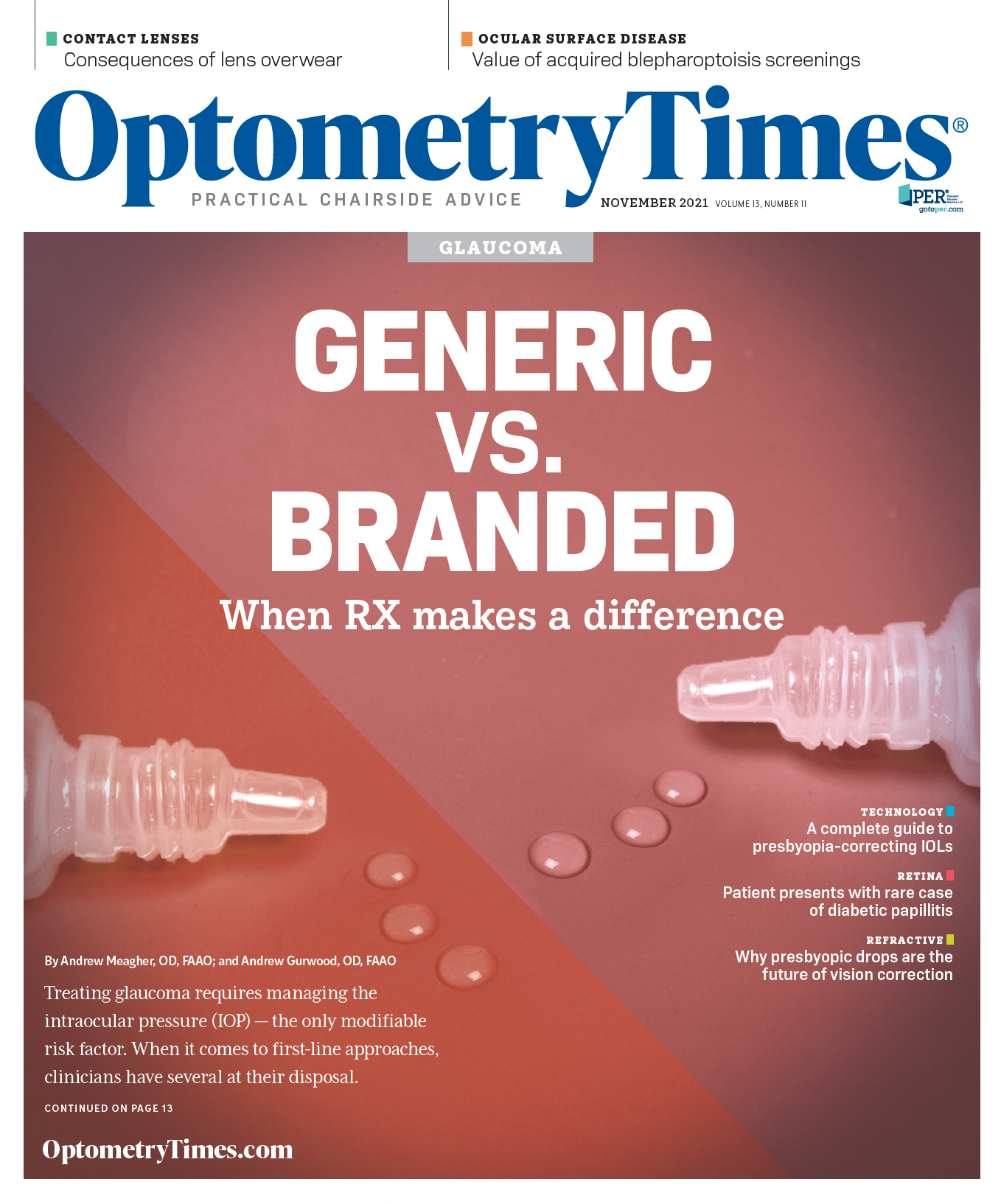
Newsletter
Want more insights like this? Subscribe to Optometry Times and get clinical pearls and practice tips delivered straight to your inbox.